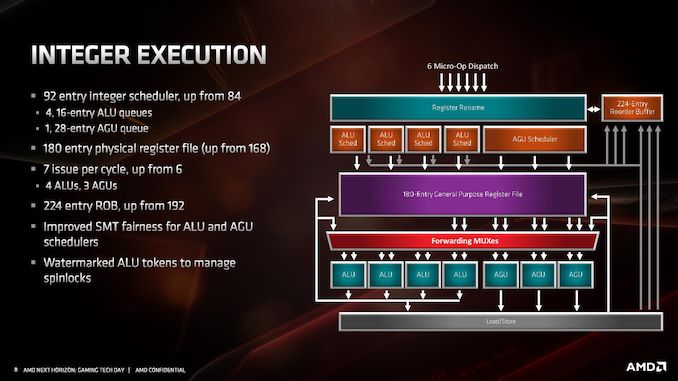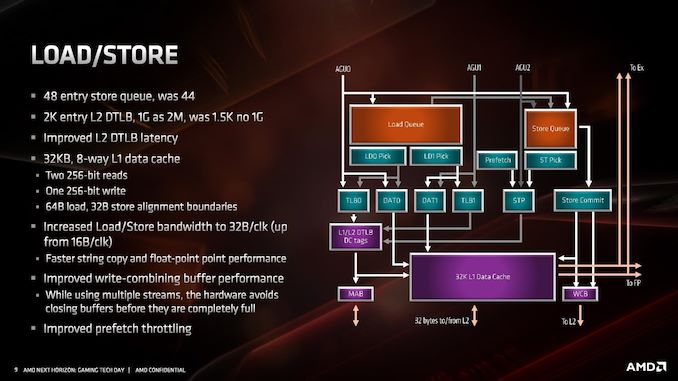AMD Zen 2 Microarchitecture Analysis: Ryzen 3000 and EPYC Rome
by Dr. Ian Cutress on June 10, 2019 7:22 PM EST- Posted in
- CPUs
- AMD
- Ryzen
- EPYC
- Infinity Fabric
- PCIe 4.0
- Zen 2
- Rome
- Ryzen 3000
- Ryzen 3rd Gen
Integer Units, Load and Store
The integer unit schedulers can accept up to six micro-ops per cycle, which feed into the 224-entry reorder buffer (up from 192). The Integer unit technically has seven execution ports, comprised of four ALUs (arithmetic logic units) and three AGUs (address generation units).
The schedulers comprise of four 16-entry ALU queues and one 28-entry AGU queue, although the AGU unit can feed 3 micro-ops per cycle into the register file. The AGU queue has increased in size based on AMD’s simulations of instruction distributions in common software. These queues feed into the 180-entry general purpose register file (up from 168), but also keep track of specific ALU operations to prevent potential halting operations.
The three AGUs feed into the load/store unit that can support two 256-bit reads and one 256-bit write per cycle. Not all the three AGUs are equal, judging by the diagram above: AGU2 can only manage stores, whereas AGU0 and AGU1 can do both loads and stores.
The store queue has increased from 44 to 48 entries, and the TLBs for the data cache have also increased. The key metric here though is the load/store bandwidth, as the core can now support 32 bytes per clock, up from 16.












216 Comments
View All Comments
Ratman6161 - Friday, June 14, 2019 - link
Better yet, why even bother talking about it? I read these architecture articles and find them interesting, but I'll spend my money based on real world performance.Notmyusualid - Sunday, July 7, 2019 - link
@ Ratman - aye, I give this all passing attention too. Hoping one day another 'Conroe' moment lands at our feet.RedGreenBlue - Tuesday, June 11, 2019 - link
The immediate value at these price points is the multithreading. Even ignoring the CPU cost, the motherboard costs of Zen 2 on AM4 can be substantially cheaper than the threadripper platform. Also, keep in mind what AMD did soon after the Zen 1000 series launch, and, I think, Zen 2 launch to a degree. They knocked down the prices pretty substantially. The initial pricing is for early adopters with less price sensitivity and who have been holding off upgrading as long as possible and are ready to spring for something. 3 months or so from launch these prices may be reduced officially, if not unofficially by 3rd parties.RedGreenBlue - Tuesday, June 11, 2019 - link
*Meant to say Z+ launch, not Zen 2.Spoelie - Wednesday, June 12, 2019 - link
To be fair, those price drops were also partially instigated by CPU launches from Intel - companies typically don't lower prices automatically, usually it is from competitive pressure or low sales.just4U - Thursday, June 13, 2019 - link
I don't believe that's true at all S. Pricing was already lower than the 8th gen Intels and the 9th while adding cores wasn't competing against the Ryzens any more than the older series..sing_electric - Friday, June 14, 2019 - link
That's true, but by most indications, if you want the "full" AM4 experience, you'll be paying more than you did previously because the 500-series motherboards will cost significantly more - I'm sure that TR boards will see an increase, too, but I think, proportionately, it might be smaller (because the cost increase for say, PCIe 4.0 is probably a fixed dollar amount, give or take).mode_13h - Tuesday, June 11, 2019 - link
Huh? There've been lots of Intel generations that did not generate those kinds of performance gains, and Intel has not introduced a newer product at a lower price point, since at least the Core i-series. So, I have no idea where you get this 10-15% perf per dollar figure.Irata - Tuesday, June 11, 2019 - link
So who does innovate in your humble opinion ?Looking at your posts, you seem to confuse / jumble quite a lot of things.
Example TSMC: So yes, they are giving AMD a better manufacturing that allows them to offer more transistors per area or lower power use at the same clock speed.
But better perf/ $ ? Not sure - that all depends on the price per good die, i.e. yields, price etc. all play a role and I assume you do not know any of this data.
Moores law - Alx already covered that...
As for the 16 core - what would the ideal price be for you ? $199 ? What do the alternatives cost (CPU + HSF and total platform cost).
If you want to look a price - yes, it did go up compared to the 2xxx series, but compared to the first Ryzen (2017), you do get quite a lot more than you did with the original Ryzen.
1800x 8C/16T 3,6 Ghz base / 4 Ghz boost for $499
3900x 12C/24T 3.8 Ghz base / 4,6 Ghz boost for $499
Now the 2700x was only $329, but its counterpart the 3700x has the same price, roughly the same frequency but a lower power consumption and supposedly better performance in just the range you mention.
Spunjji - Tuesday, June 11, 2019 - link
Nice comprehensive summary there!